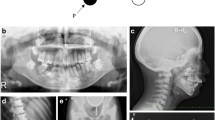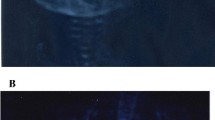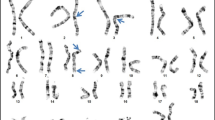Abstract
Human malignant autosomal recessive osteopetrosis (ARO) is a genetically heterogeneous disorder caused by reduced bone resorption by osteoclasts. Mutations in the CLCN7 gene are responsible not only for a substantial portion of ARO patients but also for other forms of osteopetrosis characterized by different severity and inheritance. The lack of a clear genotype/phenotype correlation makes genetic counseling a tricky issue for CLCN7-dependent osteopetrosis. Here, we characterize the first homozygous interstitial deletion in 16p13.3, detected by array comparative genomic hybridization in an ARO patient of Jordanian origin. The deletion involved other genes besides CLCN7, while the proband displayed a classic ARO phenotype; however, her early death did not allow more extensive clinical investigations. The identification of this novel genomic deletion involving a large part of the CLCN7 gene is of clinical relevance, especially in prenatal diagnosis, and suggests the possibility that this kind of mutation has been underestimated so far. These data highlight the need for alternative approaches to genetic analysis also in other ARO-causative genes.



Similar content being viewed by others
References
Villa A, Guerrini MM, Cassani B, Pangrazio A, Sobacchi C (2009) Infantile malignant, autosomal recessive osteopetrosis: the rich and the poor. Calcif Tissue Int 84:1–12
Pangrazio A, Caldana ME, Sobacchi C, Panaroni C, Susani L, Mihci E, Cavaliere ML, Giliani S, Villa A, Frattini A (2009) Characterization of a novel Alu–Alu recombination-mediated genomic deletion in the TCIRG1 gene in five osteopetrotic patients. J Bone Miner Res 24:162–167
Pangrazio A, Caldana ME, Lo Iacono N, Mantero S, Vezzoni P, Villa A, Sobacchi C (2012) Autosomal recessive osteopetrosis: report of 41 novel mutations in the TCIRG1 gene and diagnostic implications. Osteoporos Int. doi:10.1007/s00198-011-1878-5
Shinawi M, Cheung SW (2008) The array CGH and its clinical applications. Drug Discov Today 13:760–770
Pangrazio A, Pusch M, Caldana E, Frattini A, Lanino E, Tamhankar PM, Phadke S, Lopez AG, Orchard P, Mihci E, Abinun M, Wright M, Vettenranta K, Bariae I, Melis D, Tezcan I, Baumann C, Locatelli F, Zecca M, Horwitz E, Mansour LS, Van Roij M, Vezzoni P, Villa A, Sobacchi C (2010) Molecular and clinical heterogeneity in CLCN7-dependent osteopetrosis: report of 20 novel mutations. Hum Mutat 31:E1071–E1080
Valli R, Maserati E, Marletta C, Pressato B, Lo Curto F, Pasquali F (2011) Evaluating chromosomal mosaicism by array comparative genomic hybridization in hematological malignancies: the proposal of a formula. Cancer Genet 204:216–218
Daniels RJ, Peden JF, Lloyd C, Horsley SW, Clark K, Tufarelli C, Kearney L, Buckle VJ, Doggett NA, Flint J, Higgs DR (2001) Sequence, structure and pathology of the fully annotated terminal 2 Mb of the short arm of human chromosome 16. Hum Mol Genet 10:339–352
Nelson M, Quinonez S, Ackley T, Iyer RK, Innis JW (2011) Multiple congenital anomalies and developmental delay in a boy associated with a de novo 16p13.3 deletion. Am J Med Genet A 155A:612–617
Mohd Fadley MA, Ismail A, Keong TM, Yusoff NM, Zakaria Z (2012) Chromosomal 16p microdeletion in Rubinstein–Taybi syndrome detected by oligonucleotide-based array comparative genomic hybridization: a case report. J Med Case Rep 6:30
Harteveld CL, Kriek M, Bijlsma EK, Erjavec Z, Balak D, Phylipsen M, Voskamp A, di Capua E, White SJ, Giordano PC (2007) Refinement of the genetic cause of ATR-16. Hum Genet 122:283–292
Lorès P, Visvikis O, Luna R, Lemichez E, Gacon G (2010) The SWI/SNF protein BAF60b is ubiquitinated through a signalling process involving Rac GTPase and the RING finger protein Unkempt. FEBS J 277:1453–1464
Rastogi MV, LaFranchi SH (2010) Congenital hypothyroidism. Orphanet J Rare Dis 5:17
Frattini A, Pangrazio A, Susani L, Sobacchi C, Mirolo M, Abinun M, Andolina M, Flanagan A, Horwitz EM, Mihci E, Notarangelo LD, Ramenghi U, Teti A, Van Hove J, Vujic D, Young T, Albertini A, Orchard PJ, Vezzoni P, Villa A (2003) Chloride channel CLCN7 mutations are responsible for severe recessive, dominant, and intermediate osteopetrosis. J Bone Miner Res 18:1740–1747
Acknowledgments
The technical assistance of Dario Strina and of Giuseppe Montalbano is acknowledged. This work was partially supported by Fondazione Cariplo (Grant 2008-2218 to C. S.), the Telethon Foundation (Grant GGP10116 to C. S.), the PRIN Project (200999KRFW-002 to P. V.), Giovani Ricercatori from Ministero della Salute (Grant GR-2008-1134625 to C. S.), and Progetto Premiale CNR Invecchiamento.
Author information
Authors and Affiliations
Corresponding author
Additional information
The authors have stated that they have no conflict of interest.
Rights and permissions
About this article
Cite this article
Pangrazio, A., Frattini, A., Valli, R. et al. A Homozygous Contiguous Gene Deletion in Chromosome 16p13.3 Leads to Autosomal Recessive Osteopetrosis in a Jordanian Patient. Calcif Tissue Int 91, 250–254 (2012). https://doi.org/10.1007/s00223-012-9631-4
Received:
Accepted:
Published:
Issue Date:
DOI: https://doi.org/10.1007/s00223-012-9631-4




